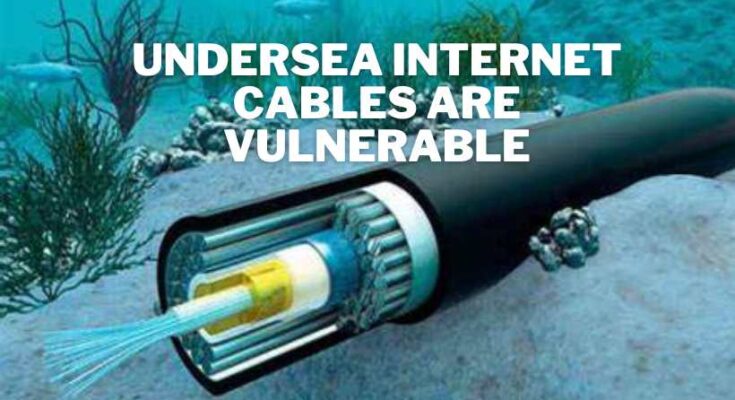Undersea internet cables are becoming increasingly vulnerable targets in future wars. The recent damage to fiber optic cables in the Red Sea, although not deliberate, highlights the ease with which these vital communication lines can be attacked.
These cables carry about 97% of the world’s internet traffic, making them a prime target for geopolitical rivals seeking to disrupt communication without taking responsibility for their actions.
While incidents of cable damage can be caused by accidents or human activity, intentional disruption poses a significant threat as countries move toward more subtle modes of warfare.
However, despite the potential for disruption, the industry is prepared for such incidents through redundancy measures and multiple cables available for routing internet traffic. Nonetheless, governments and industry players are taking steps to enhance the security of undersea cables and improve the ability to identify and prevent damage.
Increase in Undersea Cable Damage
There has been a discernible surge in the deterioration of subsea internet cables in recent times, with the Red Sea hosting one of the most alarming occurrences. This occurrence not only underscores the susceptibility of these cables but also illustrates the possible repercussions on internet bandwidth. It is of the utmost importance to comprehend the causes of cable damage and the difficulties associated with preserving their integrity in order to effectively tackle this escalating problem.
Recent destruction in the Red Sea
Three fiber optic cables were severed in the Red Sea on Monday, resulting in a substantial reduction in regional internet bandwidth. Repairing the cables, which transported around 25 percent of the region’s internet traffic, could take weeks or even months as a result of the ongoing conflict in Yemen. While the damage was not intentional, it serves to emphasize the vulnerability of cables operating at sea and the possibility of disturbances.
Consequences for bandwidth.
Portaging approximately 97% of the global internet traffic is dependent on submarine cables. Consequently, any damage to these cables can cause substantial disruptions to bandwidth and internet connectivity. The occurrence in the Red Sea serves as a poignant illustration of the potential ramifications that can arise from cable damage. Operators were compelled to promptly redirect traffic to alternative cables and satellites, which ultimately led to a decline in internet performance throughout the area.
Motive probable for cable cutbacks
The cable cuttings in the Red Sea incident are hypothesized to have been caused by the anchor of the cargo vessel Rubymar. Subsequent to being attacked by missiles, the personnel of the vessel abandoned ship, resulting in inadvertent cable damage. However, discerning the intentionality or unintentionality of cable cuts presents a formidable obstacle, thereby impeding the identification of those accountable. The absence of transparency in this context further exposes undersea cables to risk and fosters a conducive atmosphere for clandestine assaults.
Susceptibility of subsea cables
The inherent susceptibility of underwater cables stems from their vast distances and dependence on submerged infrastructure. They could be perceived by geopolitical adversaries and other entities as possible targets for disturbance. The transition towards more covert methods of assault presents a difficulty in discerning intentional harm, given that occurrences can be masked as unintended incidents.
The aforementioned susceptibility and the possibility of deliberate disturbance underscore the imperative for heightened security protocols and cooperation between governmental and industrial sectors.
Facilitation of Disruption
Submarine cables are appealing targets for deliberate disruption on account of the inherent weaknesses they possess. The challenges in ascertaining deliberate harm and the increasing prevalence of covert assaults compound the dangers linked to these critical communication infrastructures.
Cables submerged at sea as possible targets
Due to the pivotal significance that submarine cables attribute to worldwide communication, they pose an appealing target for nations embroiled in geopolitical competition. The disruption of these cables has the potential to greatly affect the connectivity of a nation and potentially cause disruptions to global communications. It is imperative to recognize the strategic significance of submarine cables in order to comprehend the necessity for heightened security protocols and proactive endeavors.
Challenges associated with identifying intentional harm
Differentiating intentional assaults on submarine cables from inadvertent damage presents a substantial obstacle. As a result of the fact that fishing nets, anchors, and natural calamities are all potential causes of undersea cable incidents, assigning liability for harm becomes complicated. The ambiguity that ensues provides an advantage to prospective offenders who seek to elude detection and responsibility for their conduct.
Transition to subtle assaults
Although the frequency of large-scale military operations has diminished, there has been a heightened susceptibility to covert assaults on subsea cables. Subtle attacks provide adversaries with the chance to exploit the susceptibilities of cables located beneath the ocean floor while evading direct accountability for their conduct. Covert attacks of this nature possess the potential to cause substantial disruptions to communication networks worldwide, thus demanding proactive measures for their detection and prevention.
Disorders and Incidents
The recurring nature of incidents affecting subsea cables underscores the persistent difficulties associated with preserving the integrity of these vital communication networks. A comprehensive comprehension of the factors contributing to cable damage, the duration of necessary repairs, and the industry’s ownership and redundancy protocols is crucial for effectively tackling this concern.
The frequency of occurrences that affect subsea cables
Unusual incidents involving submarine cables are a prevalent phenomenon, with an estimated annual count of one hundred reported incidents. The occurrences in question may span from inadvertent destruction resulting from fishing nets or moorings to intentional acts of sabotage. The recurrence of these occurrences emphasizes the necessity for resilient security protocols to safeguard subsea cables against disturbance.
The origins of cable injury
Around 66% of all incidents involving submarine cables can be attributed to human activity. Anchors and fishing netting are frequent contributors to cable damage, which underscores the inherent dangers of maritime operations. Natural disasters, including volcanic eruptions and earthquakes, can also pose significant risks to subsea cables, requiring the implementation of preparedness and contingency plans.
Time to repair and ownership
The time necessary to restore compromised subsea cables is contingent on a number of variables, such as the location of the breach and the applicable jurisdiction. Although repairs can generally be completed within a few days, more intricate situations may necessitate several weeks or even months. It is noteworthy that the ownership and maintenance of the vast majority of undersea cables are under the control of private industry, with tech titans and consortiums playing a substantial role in this regard.
Redundancy operations
As a precaution against cable damage, redundancy measures have been implemented throughout the industry. Backup cables and alternate paths can potentially guarantee continuous connectivity in the event of a cable failure.
For instance, in spite of the impairment of three cables in the Red Sea, the area retained a total of eleven operational cables that were capable of transmitting internet traffic. It is critical to implement redundancy measures in order to minimize the impact of cable damage-induced disruptions.
Sector Ownership
Private industry holds the majority of ownership in the undersea cable sector, with tech titans and consortiums playing significant roles. The participation of these entities underscores the criticality of subsea bandwidth in fulfilling worldwide communication requirements.
Private ownership of cables subsea
Undersea cables are predominantly under the ownership of private industry entities. Throughout history, significant participants in the industry have been consortiums of telecommunications providers and corporations whose sole purpose has been to sell cable capacity to providers. The implementation of this paradigm of private ownership has enabled the strategic and effective expansion of undersea cable networks.
Collaboration of tech titans and consortiums
There has been a growing involvement of tech titans and consortiums, such as Meta, Google, Microsoft, and Amazon, in the ownership and operation of undersea cables. Their undersea bandwidth investments are indicative of the increasing significance attributed to global connectivity. This engagement contributes supplementary knowledge, assets, and ingenuity to the sector, thereby augmenting the accessibility of bandwidth beneath the ocean floor.
Availability of bandwidth beneath the waters
The accumulation of substantial investments from industry participants has contributed to the gradual increase in the accessibility of undersea bandwidth. The expanding subsea cable network guarantees a resilient and interconnected worldwide communication infrastructure. The provision of bandwidth beneath the ocean floor is crucial for fostering economic expansion, promoting innovation, and facilitating international cooperation.
Access to the Internet and Disconnection
The potential disconnection and damage to cables subsea have significant ramifications for the worldwide economy. Although total disconnection is improbable in the majority of nations, the repercussions on internet accessibility can still yield substantial economic ramifications.
Implications for the global economy
The worldwide economy is profoundly dependent on internet connectivity for a multitude of critical operations. Information flow may be impeded and communication networks disrupted due to a disruption in subsea cables; this could have repercussions for industries including finance, e-commerce, and international trade. The economic losses that ensue underscore the criticality of protecting submarine cables and guaranteeing continuous internet connectivity.
Total disconnection for the majority of nations
Despite the fact that submarine cables serve as vital communication connections, it is improbable that the majority of nations would experience total disconnection in the event of cable damage. Redundancy measures implemented by the industry, such as secondary cables and alternate routes, serve to mitigate the potential for total disconnection. Nonetheless, it is not impossible for certain regions to experience limited connectivity and inferior internet performance due to partial disruptions.
The exception made for isolated nations
Island nations that rely exclusively on a single subsea cable are especially susceptible to total isolation in the case of cable damage. These nations frequently possess restricted alternative connectivity alternatives, which renders them more vulnerable to the economic and social ramifications that may ensue from disruptions in undersea cables. For these nations, the confidentiality and durability of subsea cables are paramount.
Governmental Undertakings
In light of the vulnerability and significance of subsea cables, governmental bodies have initiated measures to fortify security measures and safeguard vital communication infrastructure. Governments and industry stakeholders must work in concert to resolve the challenges associated with the vulnerability of undersea cables.
The center of coordination for NATO’s submerged infrastructure
A coordination center established by NATO is dedicated to the safeguarding of subsea infrastructure. The objective of this endeavor is to facilitate the collaboration of government and industry stakeholders in order to establish unified security protocols for pipelines and cables operating beneath the ocean floor.
Through the promotion of cooperation and the exchange of information, the coordination center of NATO endeavors to bolster the protection of vital communication infrastructure.
Combined task force of the EU
Aside from its coordination center, NATO and the European Union (EU) have formed a joint task force with the objective of tackling the issue of undersea cable security. By means of their combined capabilities, this joint task force facilitates increased coordination and cooperation between NATO and the EU in order to protect subsea infrastructure.
Strengthened security protocols
The implementation of enhanced measures to ensure the security of undersea cables is becoming an increasing priority for governments. Increasing surveillance of subsea infrastructure, employing sophisticated sensors and surveillance technologies, and utilizing data from radar, satellite images, and ship transponders are some of these measures. These measures facilitate a proactive methodology in the identification of potential hazards and the enforcement of accountability for those responsible.
Difficulties and Solutions
In order to mitigate the susceptibility of subsea cables, it is imperative to surmount a multitude of obstacles and execute efficacious remedies. For the protection of these vital communication connections, it is crucial to implement surveillance and sensor technologies, eliminate the anonymity associated with undersea infrastructure, and improve vessel identification.
Determining which vessels are at fault
In order to safeguard cables beneath the water’s surface, identifying the specific vessels that cause harm is a formidable obstacle. Although the telecom industry is capable of pinpointing the location and time of a break, it continues to face difficulties in identifying the exact source of the harm, such as the ship responsible. It is of the utmost importance to establish mechanisms that can identify vessels that are responsible for intentional damage, as well as to hold accountable those who inadvertently cause injury.
Insufficient vessel-specific data
The absence of information specific to the vessel poses a challenge in assigning accountability for cable damage. Although telecommunications companies may ascertain that a cable break was caused by an anchor, it is frequently challenging to identify the precise vessel from which the anchor originated. This constraint highlights the importance of enhanced collaboration and transparency among industry stakeholders and pertinent authorities in order to enable more precise identification and attribution.
Use of surveillance and sensors
The implementation of advanced sensor technologies and heightened surveillance of subsea infrastructure are essential for the detection and prevention of cable damage. Additional data sources, including satellite imagery, ship transponders, radar systems, and others, can furnish significant insights into the whereabouts of vessels and possible hazards to subsea cables. The integration of diverse surveillance and sensor data can facilitate the expeditious detection of potential threats and the proactive identification of anomalous activities.
Surface measurements of pressure
Readings of surface pressure present a potentially effective method for locating vessels above subsea cables. Cable operators have the ability to detect the existence of vessels and potential hazards by observing fluctuations in surface pressure. By integrating surface pressure measurements into surveillance systems, the capacity to identify and avert harm to cables submerged at sea can be fortified, consequently fortifying security protocols as a whole.
Anonymity elimination as a deterrent
Eliminating the anonymity linked to deliberate assaults on subsea cables proves to be an efficacious measure in discouraging such activities. Potential offenders would be subject to a greater risk of exposure and accountability as a result of heightened surveillance and the implementation of identification measures for vessels and their activities. Anonymity elimination is a substantial deterrent to malicious harm, as it diminishes the appeal of undersea cables as targets.
To conclude,
The potential consequences of damage to undersea cables, including disruptions to internet connectivity and the global economy, emphasize the critical nature of implementing enhanced security protocols.
Cooperation between the private sector and the public sector is essential for addressing the difficulties posed by the susceptibility of submarine cables and assuring the continuous flow of information. To fortify the safeguarding of subsea cables, it is possible to employ advanced sensor technologies, eliminate the use of anonymity as a deterrent, and implement heightened surveillance measures.
It is of the utmost importance to protect these vital communication connections in the digital age so as to preserve connectivity, promote economic expansion, and facilitate international cooperation.



